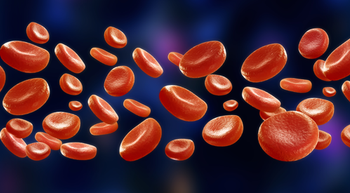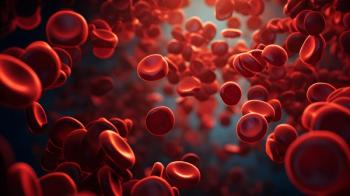
Magrolimab Gets FDA Breakthrough Designation Status for MDS Treatment
The FDA has granted a breakthrough therapy designation to magrolimab for the treatment of patients with newly diagnosed myelodysplastic syndrome (MDS), according to an announcement from Gilead Sciences, Inc.
The FDA has granted a breakthrough therapy designation to magrolimab for the treatment of patients with newly diagnosed myelodysplastic syndrome (MDS), according to an announcement from Gilead Sciences, Inc.1
The designation was based on data from an ongoing phase 1b trial (NCT03248479) that is evaluating the first-in-class, investigational anti-CD47 monoclonal antibody in combination with azacitidine in treatment-naïve patients with high and very high-risk MDS, which showed that the regimen was well tolerated and effective in this patient population.
“The breakthrough therapy designation recognizes the potential for magrolimab to help address a significant unmet medical need for [patients] with MDS and underscores the transformative potential of Gilead’s immuno-oncology therapies in development, Merdad Parsley, MD, PhD, chief medical officer of Gilead Sciences, stated in a press release.
Magrolimab was developed to inhibit recognition of CD47 by the SIRPα receptor on macrophages; by doing this, the agent is able to block the signal utilized by cancer cells to evade ingestion by the macrophages.
In the early-phase trial, investigators set out to evaluate the safety and efficacy of magrolimab in combination with azacitidine in patients with untreated higher-risk MDS. A total of 39 patients with a median age of 70 years received treatment with the combination. Twenty-eight percent of patients had intermediate cytogenetic risk and the majority, or 64%, were considered to be poor risk. Moreover, 31% of participants had therapy-related MDS and 13% of patients had TP53-mutant disease.
Results presented during the 2020 European Hematology Association Annual Congress showed that in a total of 33 patients evaluable for efficacy 91% (n = 30) achieved an objective response to the combination, with 42% experiencing a complete remission (CR), 24% having a CR in the bone marrow, 3% having a partial remission, and 9% experiencing stable disease.2 The median time to initial response was reported to be rapid, at 1.9 months, which is faster than what is expected with azacitidine by itself.
Additionally, those who responded to the treatment experienced deeper responses over time; the CR rate in those with 6 months of follow-up or longer was 56%. Cytogenetic CRs were reported in 35% of patients evaluable for response. Moreover, 22% of patients with CR or CRi in the bone marrow also had MRD negativity per multiparameter flow cytometry.
The median duration of response with the combination had not yet been reached at the time of the presentation with a median follow-up of 5.8 months. At 6 months, the majority of efficacy-evaluable participants, or 91%, continued to respond to the regimen.
Additionally, the median overall survival with magrolimab plus azacitidine had also not yet been reached; the estimated 6-month OS was 100%.
With regard to safety, the regimen was found to be well tolerated, with a safety profile comparable to that of azacitidine monotherapy. The most frequently reported treatment-related toxicities or adverse effects (AEs) of interest included anemia (44%), fatigue (18%), infusion reaction (18%), neutropenia (8%), and thrombocytopenia (5%).
Notably, febrile neutropenia was not observed with the regimen, and no participant discontinued because of an AE. Additionally, on-target anemia was reported to be mostly mild in nature, transient, and mitigated by the priming dosing regimen with several patients reducing red blood cell (RBC) transfusion requirements on treatment. With the first dose of the combination, the mean drop in hemoglobin was 0.4 g/dL. Of patients who had been dependent on RBC transfusion, 58% become transfusion independent after receiving treatment.
Magrolimab is also under investigation in the double-blind, placebo-controlled, phase 3 ENHANCE trial (NCT04313881). In the trial, investigators are examining magrolimab plus azacitidine versus azacitidine alone in treatment-naïve patients with intermediate-, high-, and very high-risk MDS per Revised International Prognostic Scoring System.
Other trials are examining the agent in hematologic and solid tumor malignancies. The agent has received fast track designation from the FDA for use in patients with MDS, acute myeloid leukemia (AML), diffuse large B-cell lymphoma, and follicular lymphoma. The FDA has also granted the drug orphan drug designation for MDS and AML; it also holds this designation in AML in Europe.
References
1. Gilead’s magrolimab, an investigational anti-CD47 monoclonal antibody, receives FDA breakthrough therapy designation for treatment of myelodysplastic syndrome. News release. Gilead Sciences, Inc. September 15, 2020. Accessed September 15, 2020. https://bit.ly/2RwPUrw.
2. Sallman D, Malki MA, Asch A, et al. The first-in-class anti-CD47 antibody magrolimab combined with azacitidine is well-tolerated and effective in MDS patients: phase 1b results. Presented at: 2020 European Hematology Association Congress; June 11-21, 2020; Virtual. Abstract S187. https://bit.ly/2FyqI1p.
This article was originally published on OncLive as, "
Newsletter
Knowledge is power. Don’t miss the most recent breakthroughs in cancer care.

















































































